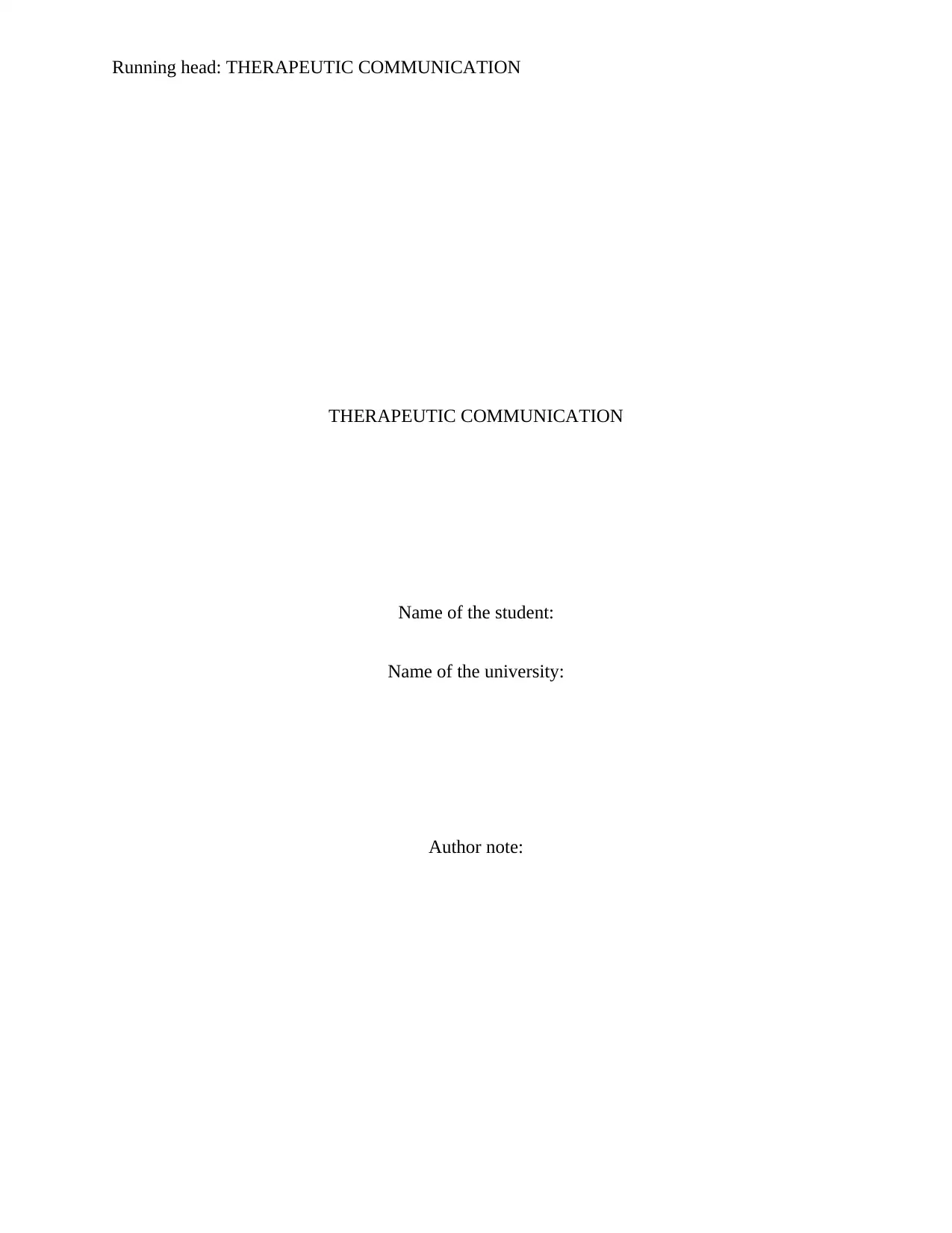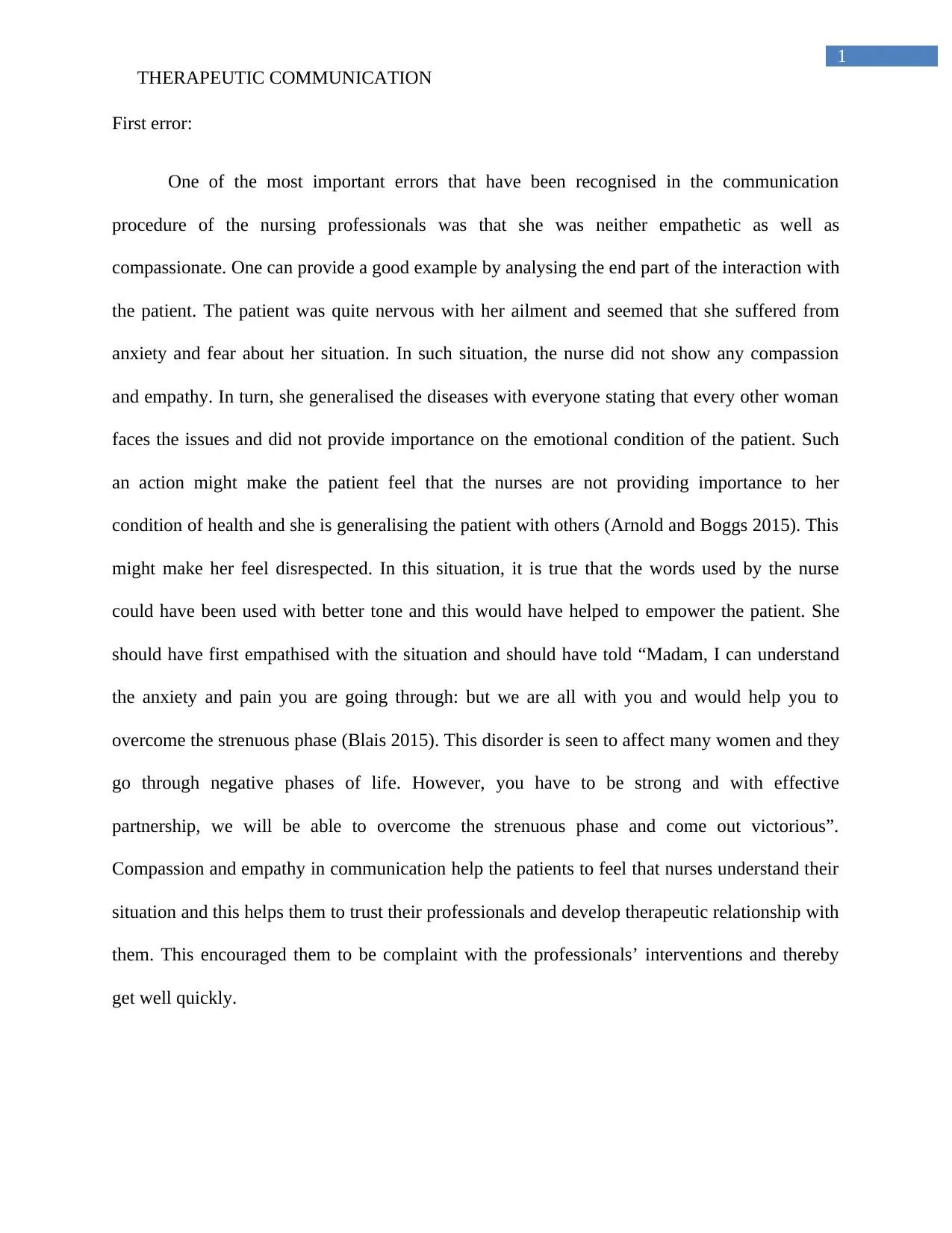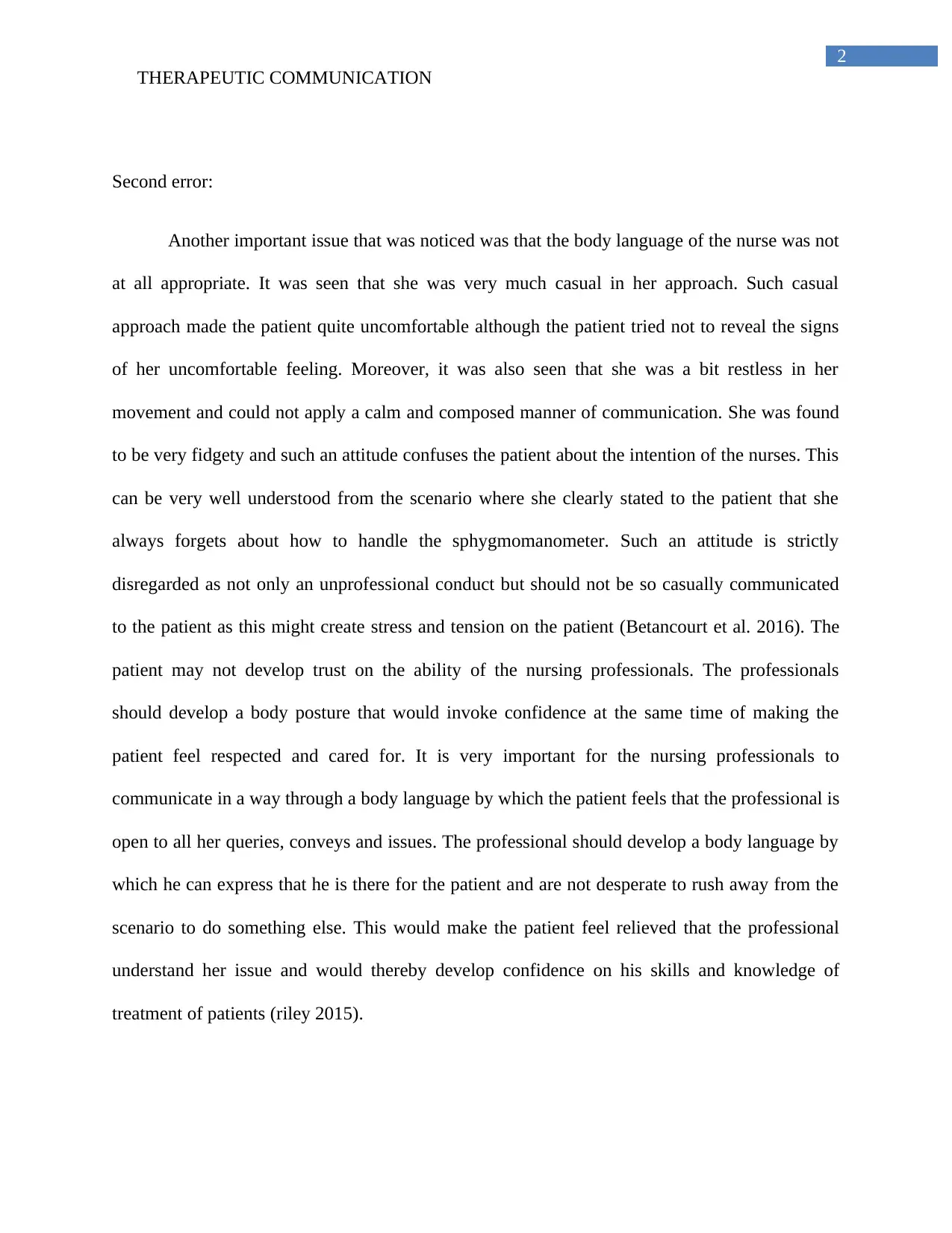Analysis of Errors in Therapeutic Communication in Nursing Practice
VerifiedAdded on 2021/06/17
|6
|1500
|606
Report
AI Summary
This report analyzes critical errors in therapeutic communication exhibited by a nursing professional. The analysis identifies four key areas of concern: lack of empathy and compassion, inappropriate body language, casual approach to patient names, and argumentative communication. The first error highlights the nurse's failure to acknowledge the patient's emotional state, generalizing her condition and showing a lack of empathy. The second error focuses on the nurse's casual and restless body language, which undermined the patient's trust and comfort. The third error addresses the nurse's disregard for the patient's name and identity. The fourth error describes the nurse's argumentative stance when the patient requested hand hygiene, resulting in the patient feeling powerless and disrespected. The report emphasizes the importance of empathy, respectful communication, and professional conduct in building a therapeutic relationship between nurses and patients, and it references several academic sources to support its claims.

Running head: THERAPEUTIC COMMUNICATION
THERAPEUTIC COMMUNICATION
Name of the student:
Name of the university:
Author note:
THERAPEUTIC COMMUNICATION
Name of the student:
Name of the university:
Author note:
Paraphrase This Document
Need a fresh take? Get an instant paraphrase of this document with our AI Paraphraser

1
THERAPEUTIC COMMUNICATION
First error:
One of the most important errors that have been recognised in the communication
procedure of the nursing professionals was that she was neither empathetic as well as
compassionate. One can provide a good example by analysing the end part of the interaction with
the patient. The patient was quite nervous with her ailment and seemed that she suffered from
anxiety and fear about her situation. In such situation, the nurse did not show any compassion
and empathy. In turn, she generalised the diseases with everyone stating that every other woman
faces the issues and did not provide importance on the emotional condition of the patient. Such
an action might make the patient feel that the nurses are not providing importance to her
condition of health and she is generalising the patient with others (Arnold and Boggs 2015). This
might make her feel disrespected. In this situation, it is true that the words used by the nurse
could have been used with better tone and this would have helped to empower the patient. She
should have first empathised with the situation and should have told “Madam, I can understand
the anxiety and pain you are going through: but we are all with you and would help you to
overcome the strenuous phase (Blais 2015). This disorder is seen to affect many women and they
go through negative phases of life. However, you have to be strong and with effective
partnership, we will be able to overcome the strenuous phase and come out victorious”.
Compassion and empathy in communication help the patients to feel that nurses understand their
situation and this helps them to trust their professionals and develop therapeutic relationship with
them. This encouraged them to be complaint with the professionals’ interventions and thereby
get well quickly.
THERAPEUTIC COMMUNICATION
First error:
One of the most important errors that have been recognised in the communication
procedure of the nursing professionals was that she was neither empathetic as well as
compassionate. One can provide a good example by analysing the end part of the interaction with
the patient. The patient was quite nervous with her ailment and seemed that she suffered from
anxiety and fear about her situation. In such situation, the nurse did not show any compassion
and empathy. In turn, she generalised the diseases with everyone stating that every other woman
faces the issues and did not provide importance on the emotional condition of the patient. Such
an action might make the patient feel that the nurses are not providing importance to her
condition of health and she is generalising the patient with others (Arnold and Boggs 2015). This
might make her feel disrespected. In this situation, it is true that the words used by the nurse
could have been used with better tone and this would have helped to empower the patient. She
should have first empathised with the situation and should have told “Madam, I can understand
the anxiety and pain you are going through: but we are all with you and would help you to
overcome the strenuous phase (Blais 2015). This disorder is seen to affect many women and they
go through negative phases of life. However, you have to be strong and with effective
partnership, we will be able to overcome the strenuous phase and come out victorious”.
Compassion and empathy in communication help the patients to feel that nurses understand their
situation and this helps them to trust their professionals and develop therapeutic relationship with
them. This encouraged them to be complaint with the professionals’ interventions and thereby
get well quickly.

2
THERAPEUTIC COMMUNICATION
Second error:
Another important issue that was noticed was that the body language of the nurse was not
at all appropriate. It was seen that she was very much casual in her approach. Such casual
approach made the patient quite uncomfortable although the patient tried not to reveal the signs
of her uncomfortable feeling. Moreover, it was also seen that she was a bit restless in her
movement and could not apply a calm and composed manner of communication. She was found
to be very fidgety and such an attitude confuses the patient about the intention of the nurses. This
can be very well understood from the scenario where she clearly stated to the patient that she
always forgets about how to handle the sphygmomanometer. Such an attitude is strictly
disregarded as not only an unprofessional conduct but should not be so casually communicated
to the patient as this might create stress and tension on the patient (Betancourt et al. 2016). The
patient may not develop trust on the ability of the nursing professionals. The professionals
should develop a body posture that would invoke confidence at the same time of making the
patient feel respected and cared for. It is very important for the nursing professionals to
communicate in a way through a body language by which the patient feels that the professional is
open to all her queries, conveys and issues. The professional should develop a body language by
which he can express that he is there for the patient and are not desperate to rush away from the
scenario to do something else. This would make the patient feel relieved that the professional
understand her issue and would thereby develop confidence on his skills and knowledge of
treatment of patients (riley 2015).
THERAPEUTIC COMMUNICATION
Second error:
Another important issue that was noticed was that the body language of the nurse was not
at all appropriate. It was seen that she was very much casual in her approach. Such casual
approach made the patient quite uncomfortable although the patient tried not to reveal the signs
of her uncomfortable feeling. Moreover, it was also seen that she was a bit restless in her
movement and could not apply a calm and composed manner of communication. She was found
to be very fidgety and such an attitude confuses the patient about the intention of the nurses. This
can be very well understood from the scenario where she clearly stated to the patient that she
always forgets about how to handle the sphygmomanometer. Such an attitude is strictly
disregarded as not only an unprofessional conduct but should not be so casually communicated
to the patient as this might create stress and tension on the patient (Betancourt et al. 2016). The
patient may not develop trust on the ability of the nursing professionals. The professionals
should develop a body posture that would invoke confidence at the same time of making the
patient feel respected and cared for. It is very important for the nursing professionals to
communicate in a way through a body language by which the patient feels that the professional is
open to all her queries, conveys and issues. The professional should develop a body language by
which he can express that he is there for the patient and are not desperate to rush away from the
scenario to do something else. This would make the patient feel relieved that the professional
understand her issue and would thereby develop confidence on his skills and knowledge of
treatment of patients (riley 2015).
⊘ This is a preview!⊘
Do you want full access?
Subscribe today to unlock all pages.

Trusted by 1+ million students worldwide

3
THERAPEUTIC COMMUNICATION
Third error:
Another important issue that also needs to be stated here was the casual approach of the nursing
professionals regarding the recollection of the name of the patient. It was seen that she
approached the patient with a wrong name and did not apologise for the mistake in a serious
manner. Even it was seen that when the patient revealed that her name was Sandra, she was even
too casual and modified the name to sandy without giving much importance to the entire
situation. Such an attitude of the nurse in the opening conversation is not at all expected as
patients might feel that her dignity is beached. She might feel that the nurse does not respect her
identity and is casual to such an extent that she called her by wrong name. Names are the first
sense of identity of human beings and calling a patient by the wrong name affects the
relationship that needs to be developed with the patient. The professionals should have gathered
enough details about the patient and should have recollected her name properly. This kind of
activities affect the respect of the patient making them feel that they are powerless of such an
extent that professionals even do not care to consider them as a unique individual (Maclean et al.
2017). They feel that their self-esteem is hurt and therefore this affects the relationship between
the nurse and the patient. In order to develop a trust worthy patient client therapeutic
relationship, nurses should be very careful about the name they use to address their patients and
thereby develop a relationship based on trust, respect, confidence, empathy and compassion
(Rider et al. 2014).
THERAPEUTIC COMMUNICATION
Third error:
Another important issue that also needs to be stated here was the casual approach of the nursing
professionals regarding the recollection of the name of the patient. It was seen that she
approached the patient with a wrong name and did not apologise for the mistake in a serious
manner. Even it was seen that when the patient revealed that her name was Sandra, she was even
too casual and modified the name to sandy without giving much importance to the entire
situation. Such an attitude of the nurse in the opening conversation is not at all expected as
patients might feel that her dignity is beached. She might feel that the nurse does not respect her
identity and is casual to such an extent that she called her by wrong name. Names are the first
sense of identity of human beings and calling a patient by the wrong name affects the
relationship that needs to be developed with the patient. The professionals should have gathered
enough details about the patient and should have recollected her name properly. This kind of
activities affect the respect of the patient making them feel that they are powerless of such an
extent that professionals even do not care to consider them as a unique individual (Maclean et al.
2017). They feel that their self-esteem is hurt and therefore this affects the relationship between
the nurse and the patient. In order to develop a trust worthy patient client therapeutic
relationship, nurses should be very careful about the name they use to address their patients and
thereby develop a relationship based on trust, respect, confidence, empathy and compassion
(Rider et al. 2014).
Paraphrase This Document
Need a fresh take? Get an instant paraphrase of this document with our AI Paraphraser

4
THERAPEUTIC COMMUNICATION
Fourth error:
The fourth issue is that the nursing professional was seen to come into an argumentative
stance with the patient when the patient had asked her to use hand hygiene. The nurse had tried
her hair in front of the patient and then without using hand hygiene she was going to treat the
patient. Therefore, when the patient asked her to wash her hands, she immediately spoke back
asking the patient whether she looked clean or not. Such a rude approach while communication
might have negative impact on the patient,. Such forms of aggressive communication may make
the patient feel powerless, as he would think that she does not have the right to speak for her own
self. This form of ineffective mode of communication may result in development of a feeling that
as the nurse in having the power in her hand, she is utilising it to prevent the patient from
speaking up as he is ill and helpless. Such a feeling may result the patient to feel powerless,
disrespected, helpless and lack of self-esteem (Goyder et al. 2015). This may make them feel
depressed and anxious. Therefore, professionals should always talk with patients in calm manner
and conduct as many activities according to the wishes of the patients to maintain their autonomy
and dignity. Nurses should provide importance to patients and work accordingly to make them
feel empowered. Such form of communication would thereby help them to feel that they are in
safe hand as of professionals who respect them, care for their desires, and pray for their good
health (Davis et al. 2014).
THERAPEUTIC COMMUNICATION
Fourth error:
The fourth issue is that the nursing professional was seen to come into an argumentative
stance with the patient when the patient had asked her to use hand hygiene. The nurse had tried
her hair in front of the patient and then without using hand hygiene she was going to treat the
patient. Therefore, when the patient asked her to wash her hands, she immediately spoke back
asking the patient whether she looked clean or not. Such a rude approach while communication
might have negative impact on the patient,. Such forms of aggressive communication may make
the patient feel powerless, as he would think that she does not have the right to speak for her own
self. This form of ineffective mode of communication may result in development of a feeling that
as the nurse in having the power in her hand, she is utilising it to prevent the patient from
speaking up as he is ill and helpless. Such a feeling may result the patient to feel powerless,
disrespected, helpless and lack of self-esteem (Goyder et al. 2015). This may make them feel
depressed and anxious. Therefore, professionals should always talk with patients in calm manner
and conduct as many activities according to the wishes of the patients to maintain their autonomy
and dignity. Nurses should provide importance to patients and work accordingly to make them
feel empowered. Such form of communication would thereby help them to feel that they are in
safe hand as of professionals who respect them, care for their desires, and pray for their good
health (Davis et al. 2014).

5
THERAPEUTIC COMMUNICATION
References:
Arnold, E.C. and Boggs, K.U., 2015. Interpersonal Relationships-E-Book: Professional
Communication Skills for Nurses. Elsevier Health Sciences.
Betancourt, J.R., Green, A.R., Carrillo, J.E. and Owusu Ananeh-Firempong, I.I., 2016. Defining
cultural competence: a practical framework for addressing racial/ethnic disparities in health and
health care. Public health reports.
Blais, K., 2015. Professional nursing practice: Concepts and perspectives. Pearson.
Goyder, C., Atherton, H., Car, M., Heneghan, C.J. and Car, J., 2015. Email for clinical
communication between healthcare professionals. The Cochrane Library.
MacLean, S., Kelly, M., Geddes, F. and Della, P., 2017. Use of simulated patients to develop
communication skills in nursing education: An integrative review. Nurse education today, 48,
pp.90-98.
Rider, E.A., Kurtz, S., Slade, D., Longmaid, H.E., Ho, M.J., Pun, J.K.H., Eggins, S. and Branch,
W.T., 2014. The International Charter for Human Values in Healthcare: an interprofessional
global collaboration to enhance values and communication in healthcare. Patient education and
counseling, 96(3), pp.273-280.
Riley, J.B., 2015. Communication in nursing. Elsevier Health Sciences.
THERAPEUTIC COMMUNICATION
References:
Arnold, E.C. and Boggs, K.U., 2015. Interpersonal Relationships-E-Book: Professional
Communication Skills for Nurses. Elsevier Health Sciences.
Betancourt, J.R., Green, A.R., Carrillo, J.E. and Owusu Ananeh-Firempong, I.I., 2016. Defining
cultural competence: a practical framework for addressing racial/ethnic disparities in health and
health care. Public health reports.
Blais, K., 2015. Professional nursing practice: Concepts and perspectives. Pearson.
Goyder, C., Atherton, H., Car, M., Heneghan, C.J. and Car, J., 2015. Email for clinical
communication between healthcare professionals. The Cochrane Library.
MacLean, S., Kelly, M., Geddes, F. and Della, P., 2017. Use of simulated patients to develop
communication skills in nursing education: An integrative review. Nurse education today, 48,
pp.90-98.
Rider, E.A., Kurtz, S., Slade, D., Longmaid, H.E., Ho, M.J., Pun, J.K.H., Eggins, S. and Branch,
W.T., 2014. The International Charter for Human Values in Healthcare: an interprofessional
global collaboration to enhance values and communication in healthcare. Patient education and
counseling, 96(3), pp.273-280.
Riley, J.B., 2015. Communication in nursing. Elsevier Health Sciences.
⊘ This is a preview!⊘
Do you want full access?
Subscribe today to unlock all pages.

Trusted by 1+ million students worldwide
1 out of 6
Related Documents
Your All-in-One AI-Powered Toolkit for Academic Success.
+13062052269
info@desklib.com
Available 24*7 on WhatsApp / Email
![[object Object]](/_next/static/media/star-bottom.7253800d.svg)
Unlock your academic potential
Copyright © 2020–2025 A2Z Services. All Rights Reserved. Developed and managed by ZUCOL.




